What It Is and How to Create One
What Is a Marketing Strategy?
Marketing strategy is your company’s long-term game plan for how you’ll reach your audience, promote your products or services, and convert prospects into customers.
A documented strategy informs each marketing campaign by defining how your company positions itself, the language you use, your target market, and where you’ll communicate with them.
Why Do You Need a Marketing Strategy?
Marketing without a strategy is essentially throwing ideas at the wall and seeing what sticks. While you may eventually find something that works, you’re wasting budget, time, and resources in doing so.
An effective marketing strategy provides structure and consistency. It helps:
- Connect your marketing efforts and business objectives to ensure each campaign benefits your long-term business goals
- Align teams to specific goals, as businesses with teams on the same page (e.g., sales and marketing) sell more, grow faster, and have higher customer retention
- Promote ongoing optimization for improved performance and return on investment (ROI), to ensure marketing efforts continually engage the right people
These benefits directly impact performance.
CoSchedule research shows that marketers are 414% more likely to report success when they document their strategy. Simply organizing your marketing efforts increases your chances of success sevenfold.
Despite this, 40% of marketers don’t have a documented strategy. By creating one, you gain a competitive advantage.
The Difference Between a Marketing Strategy and a Marketing Plan
The terms “marketing strategy” and “marketing plan” are often used interchangeably. Both play a key role in your marketing performance, but it’s important not to confuse the two.
- A marketing strategy is the what. It details your long-term purpose and approach to marketing.
- A marketing plan is the how. It details the tactical approach you’ll use to achieve the objectives in your marketing strategy.
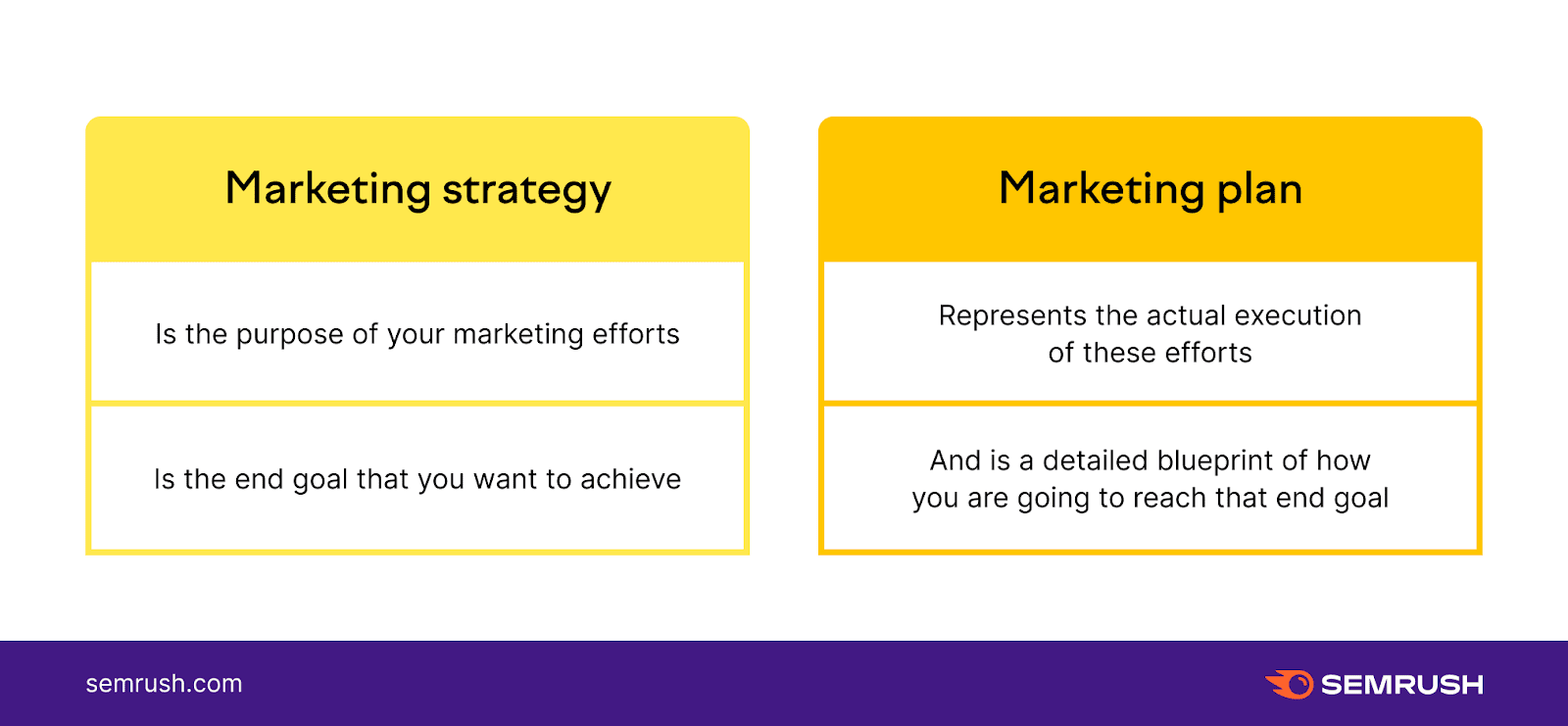
The strategy informs the plan. And the plan makes good on the strategy. In other words, you can’t have a successful marketing plan without a successful marketing strategy.
What Should Your Marketing Strategy Include?
Your marketing strategy is a repeatable framework for your marketing initiatives. It’s a template for where to start and a clear vision of where you need to get to.
Think of it like a blueprint for a house. If you gave that blueprint to five different builders, the methods they use to build the house may differ, but the completed project will always match the blueprint and core strategy at play.
Your marketing strategy needs to include the following:
- Marketing objectives: What you hope to achieve from your marketing campaigns (e.g., greater brand awareness, more leads, or increased sales)
- Target audience: The group of people identified as potential customers
- Value proposition: The number one reason why your product or service is the best choice for your target audience
- Marketing channels: The platforms and tools (e.g., SEO, social, email) you’ll use to reach customers. Successful marketing is the result of promoting your product in the right place at the right price
- Brand messaging: The tone of voice and language you’ll use to communicate your value proposition
- Performance analysis: The tools you’ll use (e.g., Twitter or LinkedIn ad metrics) to measure the success of marketing campaigns against your goals
To bring these elements together, follow these six steps.
1. Determine Your Marketing Goals
Clear marketing goals drive high-quality marketing strategies. A vague goal such as “secure more revenue” is a legitimate aim, but it isn’t specific or measurable enough to define success.
That’s because it lacks key factors to make it actionable. Such as:
- What defines a lead (e.g., a form submission, phone call, ad click)?
- How many leads do you want to secure?
- How many leads need to convert?
- How much should you spend per lead?
Start by looking at the big picture. Reverse engineer big goals to create smaller, achievable goals that contribute to overarching objectives.
For example, if your goal is to reach $500,000 in monthly recurring revenue (MRR), look at average order/contract value to figure out how many deals you have to win to reach this goal.
Use the SMART framework to home in on what you want to achieve within a specific period:
- Specific
- Measurable
- Attainable
- Relevant
- Time-bound
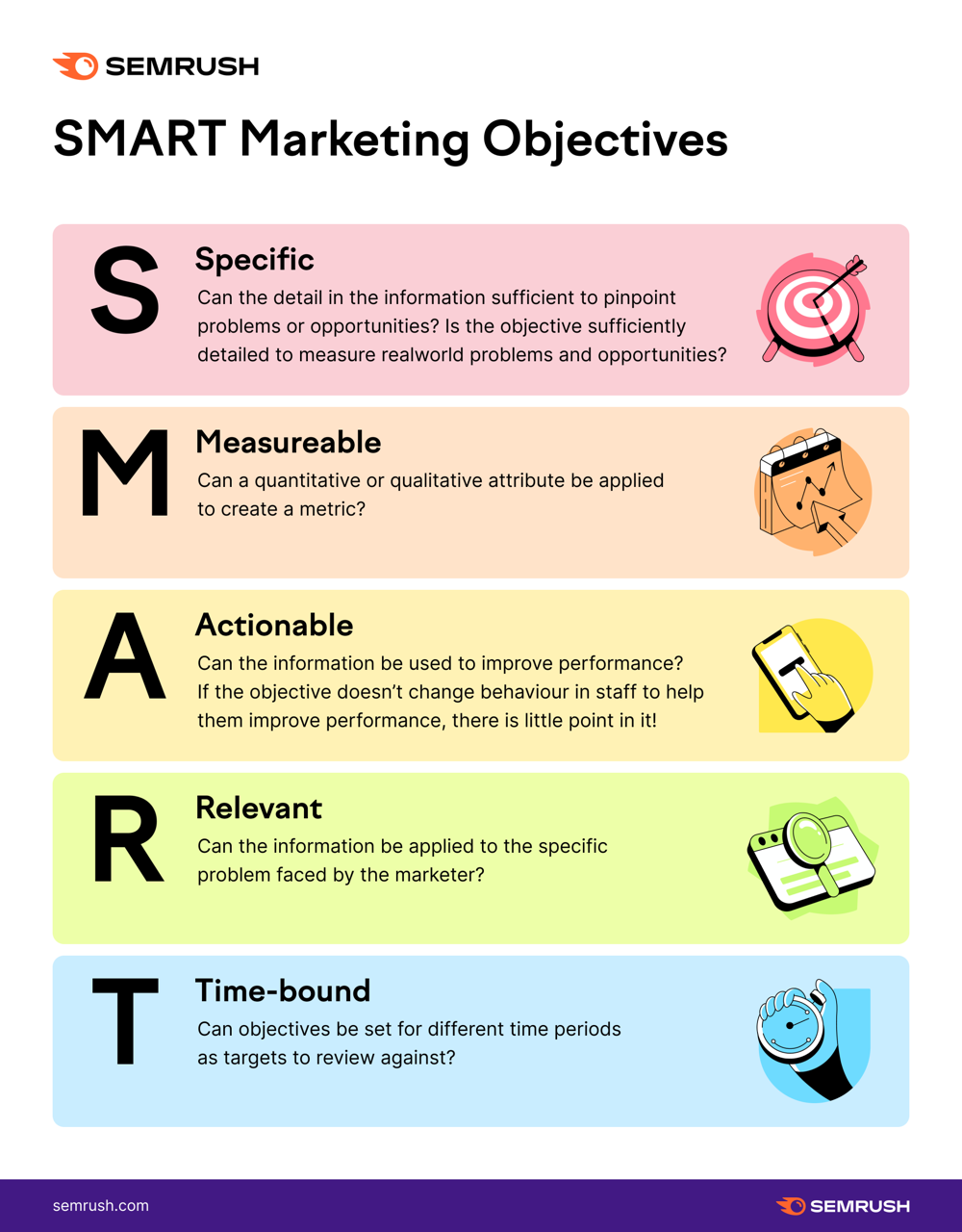
Using this methodology gives the goal clarity. For example, by applying each of the five SMART characteristics, “secure more revenue” becomes “get 30% more leads into the proposal stage by the end of Q2.”
The goal is now realistic and achievable.
With goals in place, attach valid marketing metrics to measure progress. Using the example of leads, common metrics include:
- Lead conversion rate
- Lead-to-sale conversion rate
- Customer acquisition cost
- Customer lifetime value
- Click-through rate
- Bounce rate
- Return on investment
- Time to conversion
For ecommerce-related goals, you might include:
- Average order value
- Cart abandonment rate
- Sales conversion rate
- Average inventory sold per day
Reverse engineering from revenue or growth to marketing gives stakeholders a high-level position to track performance toward the ultimate goal.
SMART goals let marketers know exactly what they have to achieve to reach that goal.
2. Define Your Audience And Buyer Personas
Marketing strategies are only effective if you understand your target customer.
Your marketing strategy should detail customers on two levels:
1. Target Audience
Your target audience is an overview of your customer base, broken down into two general categories:
- Demographic traits: Basic characteristics customers have in common. This includes factors such as age, gender, location, education, and income.
- Psychographic traits: Information on your audience’s personality, lifestyle, interests, and values.
Here’s what an example target audience for a SaaS startup might look like
- Gender: Male
- Age: 30-50 years old
- Education: High school and college
- Annual Income: $50,000 to $100,000
- Location: Midwest United States
- Interests: Business and travel
2. Buyer Personas
Buyer personas give a zoomed-in look at specific members of your target audience. They look at several factors to create a fictionalized version of a customer.
- Background: Personal details such as where they work, where they live, and the make-up of their family
- Identifiers: Interests, values, and personality traits
- Goals and challenges: What they need, the problem they want to overcome, and what they want to achieve
- How you can help: What you do to help customers overcome concerns and achieve their goals
Here’s a buyer persona example for the same SaaS startup created using the Semrush Persona tool:

Think of the target audience as the team and buyer personas as the players. Creating a target audience is the first step. This gives you an overall market to focus on. From there, you can use buyer personas to reach specific market segments.
For example, take a look at the typical Awareness, Interest, Desire, Action (AIDA) marketing funnel:

If your goal is to build brand awareness, you’ll want to target the broadest range of people at the top of the funnel. It makes sense to focus on your target audience—the team. You can reach people that you know are interested in your product to build trust and attract leads.
As customers move down the funnel to the Desire stage, messaging needs to become more specific and sales-driven to convince them that your product or service meets their needs. Buyer personas help you speak to a specific, targeted group that you know will be interested in making a purchase rather than a broad, general cohort that won’t be motivated to invest further time or money.
How to Conduct Effective Research
You’ll likely have an idea of the type of person you want to target, but don’t let assumptions drive your strategy. Pay attention to data, not hunches, or you may miss less obvious desires or pain points that are key to building relationships.
Rather than define customers on how well you think you know them, identify your audience and personas and their problems.
- Segment and analyze your existing customers: What common traits do they share?
- Interview customers to gather qualitative data: Ask opened-ended questions, such as: When did you realize you needed this product/service? What alternatives did you consider? What concerns did you have before buying? Why did you choose us?
- Gather customer feedback from reviews and support requests: Which common pros and cons come up when people talk about your products/services?
- Survey customer-facing teams to learn about common customer questions and problems: What issues do people encounter when using your product/service or interacting with your business?
- Use analytics tools (e.g., Google Analytics and your customer relationship management or CRM) to view historical data and trends: Look forshared demographics and behaviors in your audience that can shape your personas.
Use the Semrush Persona tool to define personas. You can give your persona a profile picture and fill out their bio, frustrations, motivations, demographic info, company goal, role in the buying process, and more.
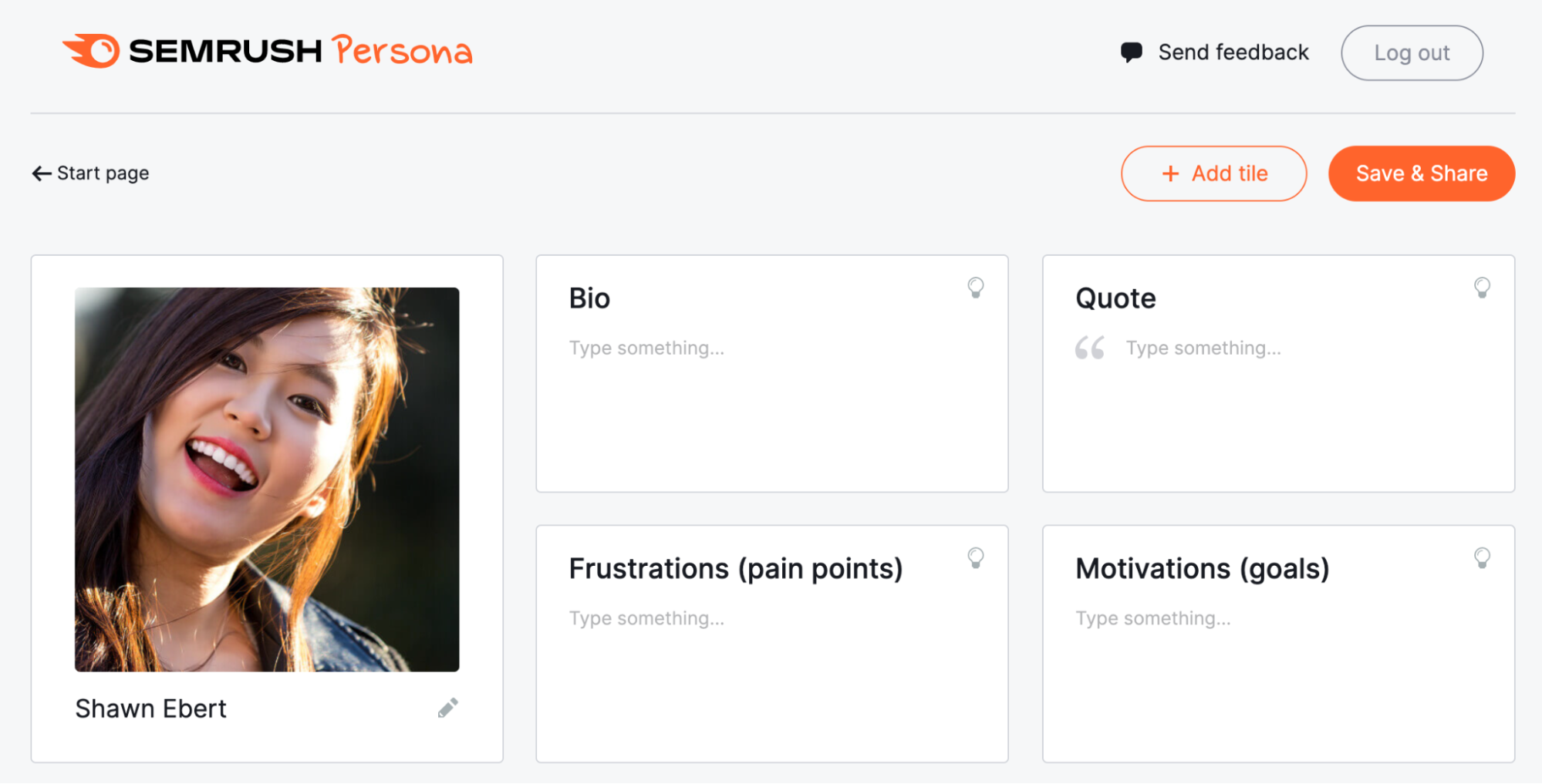
Having a clear idea of who you’re communicating with will make it easier to engage the right people with the right content.
3. Run a Competitive Analysis to Determine How You’ll Stand Out
Why should customers choose you?
That’s the question your marketing strategy has to answer. To stand out, you have to learn what competitors are doing to understand where you differ.
Make a list of your top competitors. Then analyze how they market their products or services. If you’re unsure about who your main competitors are, carry out some market research to examine your target market.
A fast way to do this is with the Semrush Market Explorer Overview Report.
From the Semrush Projects dashboard, go “Trends” > “Market Explorer.” Hit “Find Competitors” and then enter the domain you want to analyze.
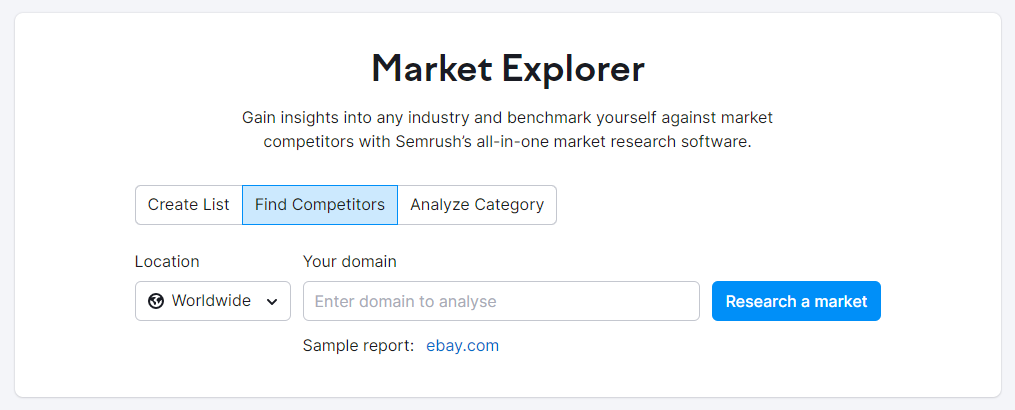
Market Explorer will identify key players in your industry. Here’s the market summary for eBay:

We can see eBay’s main competitors are Amazon (26.78% market share), Fandom (17.06% market share), and AliExpress (4.65% market share).
We can also see that the market is large with room for growth. This bodes well for the future of any business that can establish itself.
The “Growth Quadrant” identifies more competitors and where each fits into the market: which are the leaders and which are the game-changers.
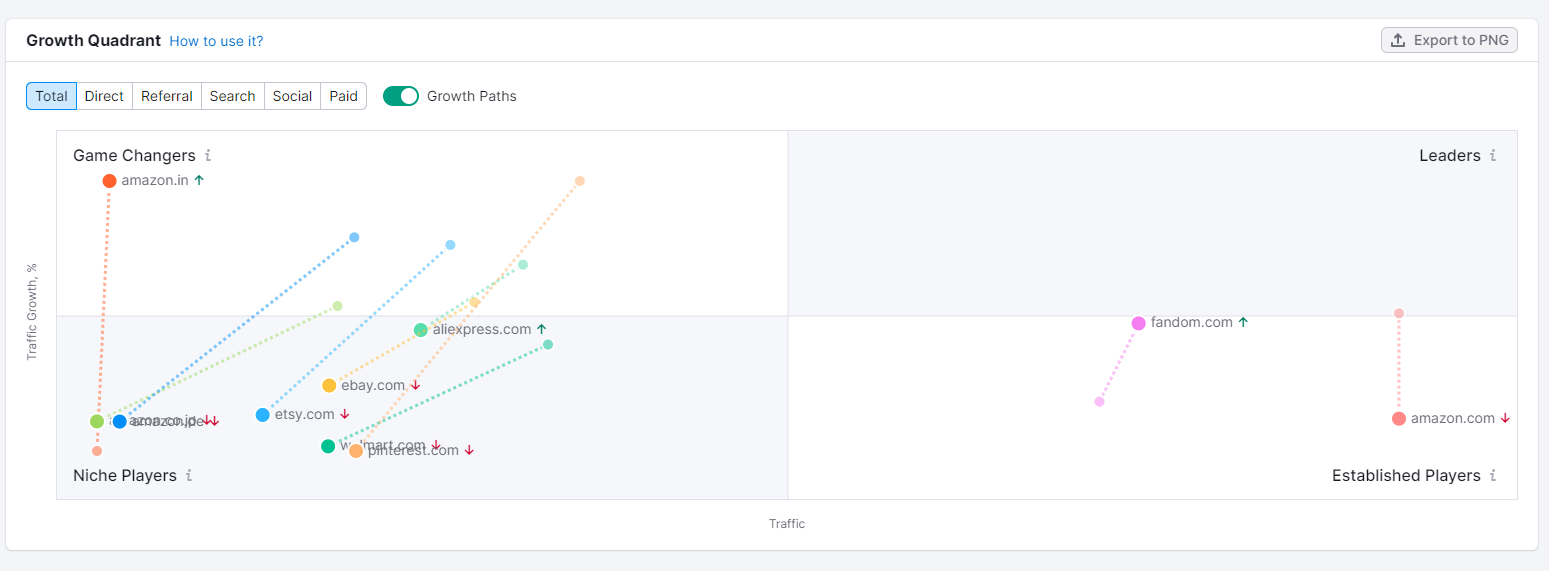
For each competitor, analyze the four Ps (products, pricing, placement, promotion). Successful marketing is the result of promoting your product in the right place at the right price.
To understand how they position themselves, look at, find gaps in, and figure out how to differentiate from:
- Their website: Use the Semrush Traffic Analytics report to find your competitors’ top pages. How do they talk about their products/services? What primary benefits do they describe? Who are products/services aimed at?
- Their social media: What channels are they using? When are they posting? What are they posting about? Do they run ads or use user-generated content (UGC) to market products/services?
- Their offers: What’s compelling about their promotions? What would make a buyer choose them over you?
- Their content marketing: What subjects do they talk about in blog posts and email marketing campaigns? How do they solve problems and deliver value?
- Their reviews, testimonials, and results: What do customers say about products/services? How do case studies describe problems and values?
Run a SWOT Analysis to Identify Your Strengths And Weaknesses
Use the information you’ve gathered from competitor research to evaluate how your product or services stack up against theirs.
The SWOT framework is a quick way to map out internal and external factors.
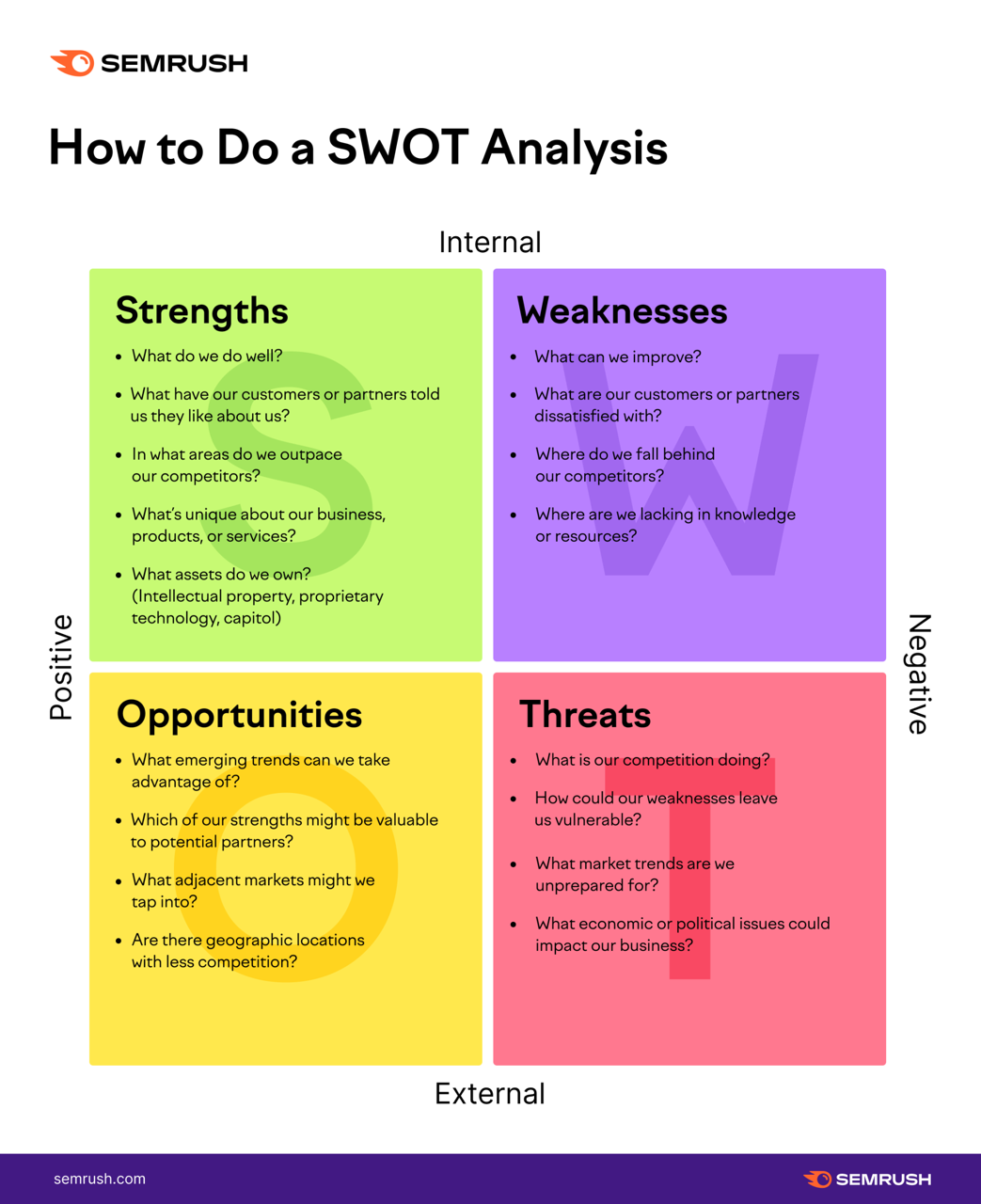
- Strengths: Identify what your business has that the competition doesn’t. For example, do you have a unique selling point (USP), a loyal customer base, or strong internal know-how?
- Weaknesses: Define your limitations and what stands in the way of you reaching your full potential. What can you improve? Where do you fall behind the competition? Where are you lacking in knowledge or resources?
- Opportunities: What market trends can you capitalize on? For example, is your market expanding? Are more people likely to need your product? Do you have a growing following?
- Threats: What external obstacles are in the way of you achieving your goals? For example, is there emerging competition? Are there changing regulations that will affect you? Do you have the resources to meet long-term customer needs?
Use Differentiation to Establish Your Value Proposition
The combination of competitor and SWOT analysis, as well as what you know about your target market, will help define the unique value your business offers and provide the source material for your value proposition.
A great value proposition should focus on how customers define your value.
For example, Stripe is a suite of tools developed to help online business process payments.
- The company’s target market is internet businesses of all sizes
- The customer’s problem relates to managing the financial aspects of the business (e.g., sending and receiving payments)
- The solution is Stripe’s all-in-one program that lets customers accept payments, send invoices, and manage finances in one place
Its value proposition clearly explains what target users will get out of its product: “Financial infrastructure for the internet.”
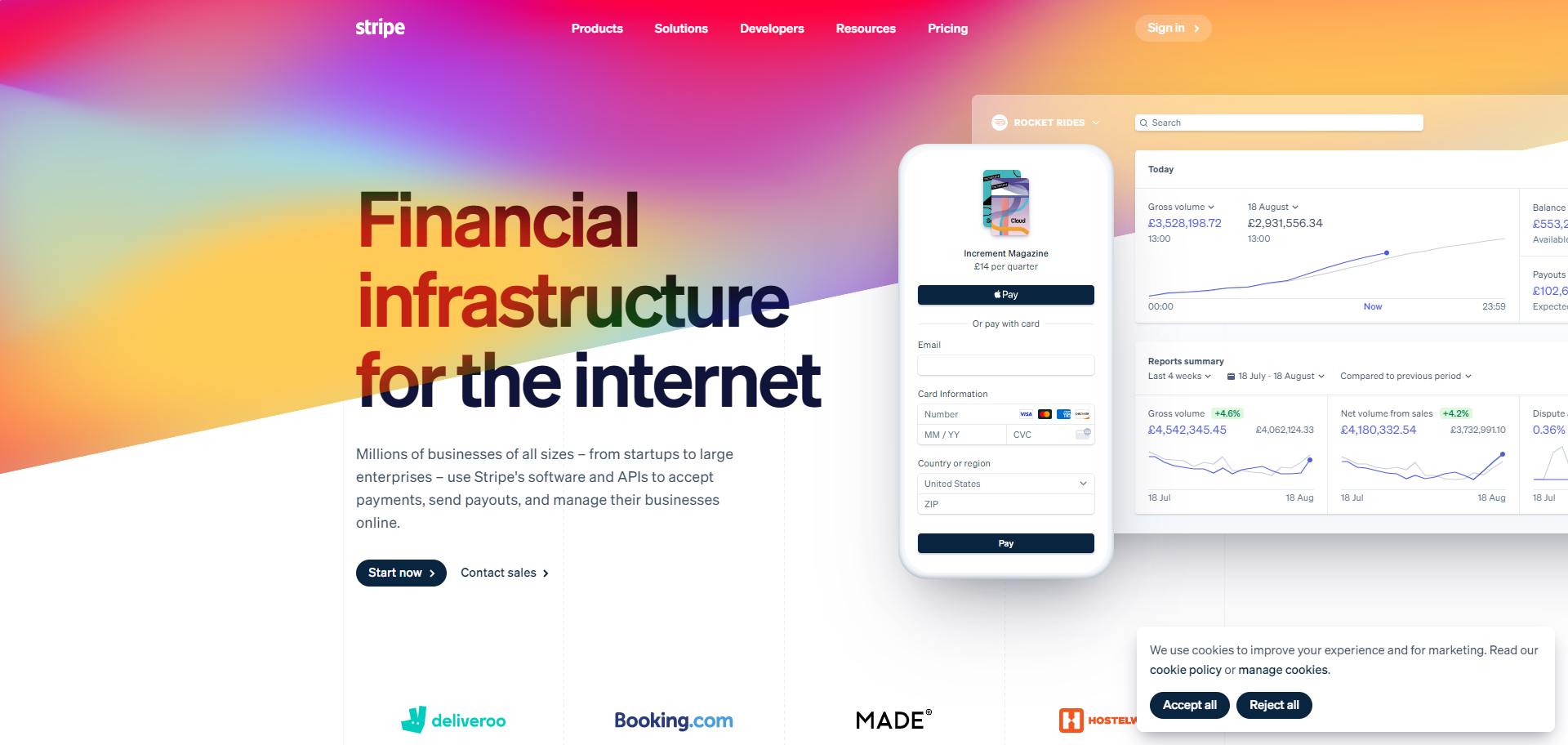
To nail your value proposition, brainstorm ideas around Harvard Business School’s three prompt formula:
1. Which customers are you going to serve?
2. Which needs are you going to meet?
3. What relative price will provide acceptable value for customers and acceptable profitability for the company?
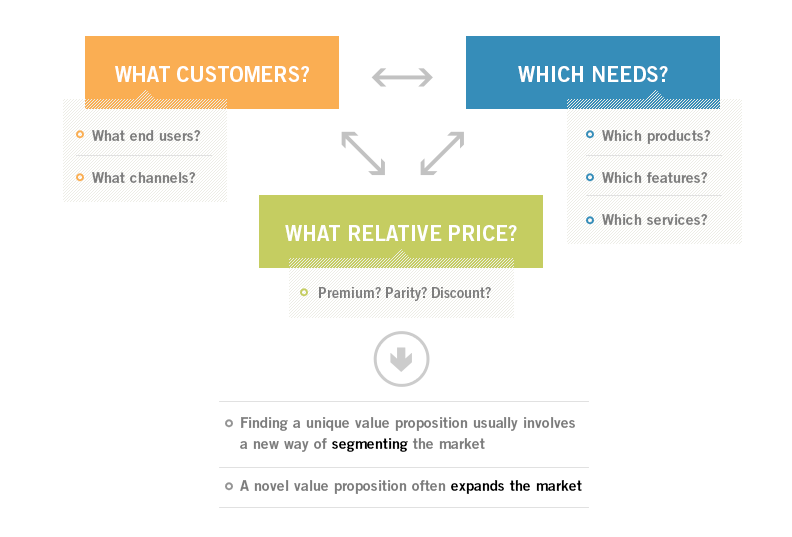
Answering these questions will bring you closer to a concise value proposition.
Write down four or five different options and narrow down from there. When you’re down to two candidates, split-test them internally and in marketing materials to find the value proposition that best resonates with your brand and audience.
Learn more about split tests in our A/B testing guide.
4. Create Messaging That Resonates with Your Audience
Your value proposition sets the tone for how to talk to your audience and what you want them to feel.
Research by Unbounce found that effective copy has more than twice the impact of design on conversion rates.

The right messaging creates familiarity, builds trust, and ultimately drives sales. But to resonate, what you say and how you say it has to be consistent across your marketing channels.
Take Lush. Its brand is built on making “effective products from fresh organic fruit and vegetables.” It positions itself as a quirky, colorful, indulgent, and ethical brand and this comes across at every touchpoint.
Its conversational messaging makes customers feel special.

Words like “gorgeous” and “wonderful” are welcoming and help to create a positive brand perception.
That same personable approach is present in Lush’s emails:

And product copy:

Exposing the audience to the same core messages and visual branding repeatedly solidifies brand recognition, fostering confidence and helping Lush stand out from the competition.
By delivering a consistent experience, the brand has amassed millions of passionate followers who shout about the brand’s products and back them when they take a stand on social issues.
Detailing brand messaging in your marketing strategy ensures marketing campaigns speak the language of your customers.
If you’re unsure of the message and feelings you want to convey to customers, now is the time to nail it down.
Our guide on how to define your brand’s tone of voice walks you through the steps, but here’s a quick overview:
1. Define your core values by creating a mission statement and communication goals (i.e., adjectives that describe your business)
2. Define your tone of voice. Establish characteristics that define how you want to communicate (e.g., funny vs. serious, formal vs. casual, respectful vs. irreverent, enthusiastic vs. matter-of-fact)
3. Observe your audience to find out how they interact with each other on their preferred channels. What tone and words do they use? This will allow you to tweak your voice for the channel (e.g., more casual on Instagram and more formal on LinkedIn).
4. Set clear brand guidelines for correct usage across channels
Include your brand guidelines in your marketing strategy to keep everyone on the same page. Provide details on:
- Target audience voice
- Brand attitude to your audience (i.e., how funny or serious to be on specific channels)
- Core brand values
- Vocabulary to use
- Vocabulary to avoid
- Grammar rules (e.g., abbreviations and acronyms, capitalization, active voice, punctuation, etc.)
Where possible, give examples of how messaging has been used effectively in past marketing assets.
Detail Your Brand Assets
Match your visual aesthetic to your tone of voice. Include details on the do’s and don’ts of your brand assets in your marketing strategy.
- How to spell and stylize your brand name
- How to use your brand logo
- Which colors to use in marketing materials
Take a look at how Mailchimp instructs users on the proper use of its name and logo:
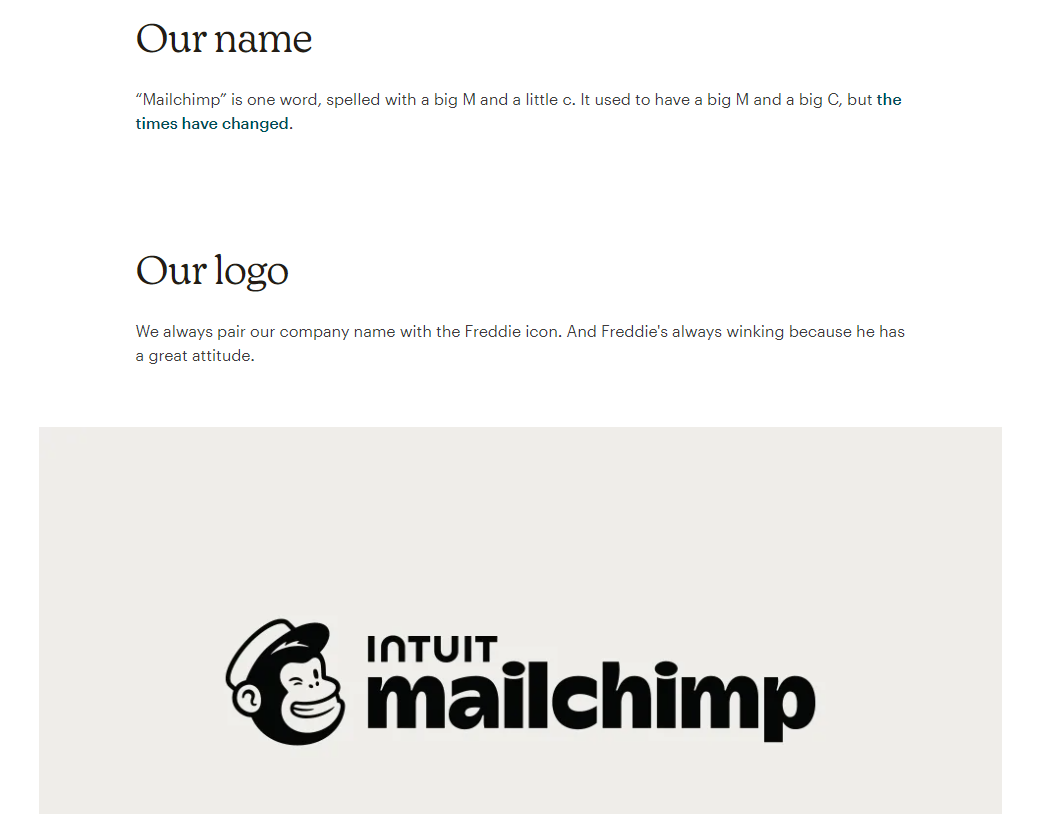
A simple example and reason why assets should be used in this way eliminates confusion, ensuring alignment across Mailchimp’s marketing channels.
Think of the messaging section of your marketing strategy as a playbook. Stick to what marketers need to know to do their job effectively. If you have in-depth brand guidelines, you can always link to them for further reading.
5. Choose Your Marketing Channels Based on Customer Feedback
Marketing channels can be grouped into three broad categories:
- Owned channels: Content platforms that belong to your company or brand (e.g., blogs, landing pages, social media profiles, newsletters, apps, and gated content)
- Earned or shared channels: Platforms that belong to a third party that shares content about your brand (e.g., guest blogs, review sites, influencer channels, and news sites)
- Paid channels: Platforms in which you pay to promote your content (e.g., paid ads, social ads, sponsored content, influencer or brand partnerships)
Where and when you promote your content will partly depend on your goals and budget.
If you aim to grow at high speed, focusing on paid channels may generate quick results. But this will only last for as long as your budget stretches.
Owned and earned organic channels will take longer to see results. But progress is more sustainable and stable.
The other deciding factor is your audience. Effective marketing reaches customers where they hang out online. Your customer research will inform which channels to prioritize.
Review your customer research data to understand:
- Which social media platforms they mostly use
- Where they look for information when researching products/services
- How often they check their emails
Supplement this with what you know about your existing content.
- Which channels or content worked well for you in the past?
- Which fell short?
This information will give you a starting point for the kind of content to create and where to distribute it.
For example, if customers use Google to research new products and your analysis tells you an old blog post drove traffic through search, experimenting with SEO-friendly owned channel content might help increase visibility. You can then combine this with paid search ads to capture attention.
It’s a tactic that Gillette uses well to promote its beard grooming products. In a search for “tips for beard growth,” an ad for Gillette’s Beard Thickener appears at the top of search results.
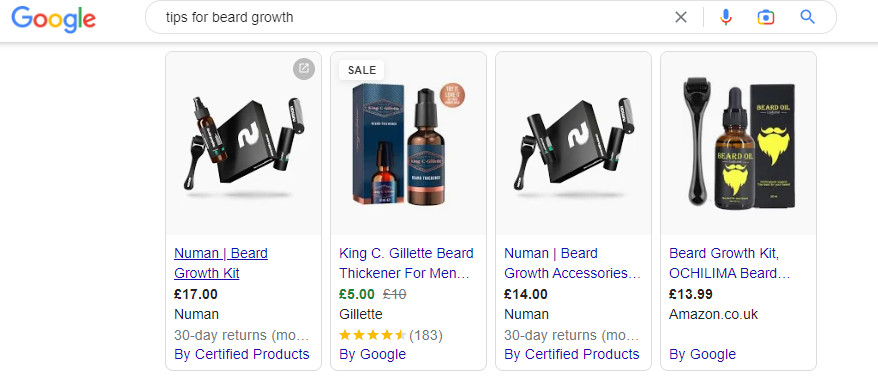
Scrolling down the page, we find Gillette again. This time with a guide on “How to Grow a Beard.”
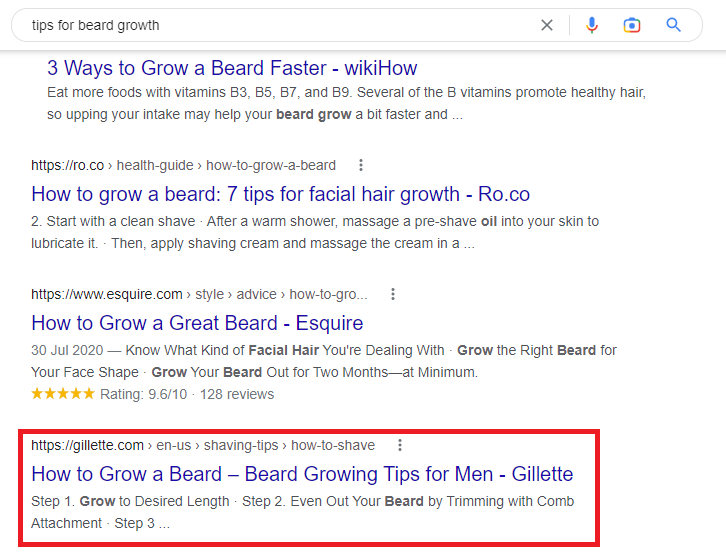
By combining paid and organic content, Gillette reaches a broader audience in the research stage with content that takes up valuable SERP real estate. It also capitalizes on intent by showcasing a product that can help customers solve their problem.
Homing in on the right channels will require some testing. Try out different versions of the same content on different platforms and measure results. For example, you may run the same video ad on Instagram and TikTok to see which generates the most engagement.
List the channels you’ll be using, along with your budget for distribution. To calculate how much to dedicate to marketing, follow Entrepreneur’s “marketing math”:
- New companies: If you’ve been in business for one to five years, use 12-20% of your gross or projected revenue on marketing
- Established companies: If you’ve been in business for more than five years and have some market share, allocate 6-12% of gross or projected revenue for marketing
For testing channel experiments, Tuff recommends allocating the following budgets:
- Ideal: 5-8% of projected revenue for channel optimization
- Funded: 5-10k for testing two or three channels at once
- Bootstrapped: 2-3k for testing one channel at a time
These figures will vary based on your tech stack and expenses, but they will help you understand how much it will cost to run initial campaigns.
Remember, your marketing strategy is a living document. The channels and budget you choose now aren’t set in stone. As data rolls in and you learn more about what your audience engages with, evolve your platforms and spending to match your goals.
Your digital marketing strategy should mature to ensure each new marketing plan is better than the last.
To streamline performance::
1. Select tools that help your team work effectively and efficiently
2. Gather data and optimize for continued improvement
Streamline Marketing Workflows with Automation
Ideally, marketers should be able to spend the majority of their time focused on content creation: brainstorming ideas, writing copy, designing and testing ads, etc.
To enable this, automate any mundane, repetitive, or resource-intensive tasks with marketing automation software.
If you’ve ever received a welcome email or interacted with a chatbot on a company website, you’ll have experienced marketing automation in action.
Think of automation software as a personal assistant. Tools streamline a wide range of marketing tasks to save you time, increase productivity, and reduce human error.
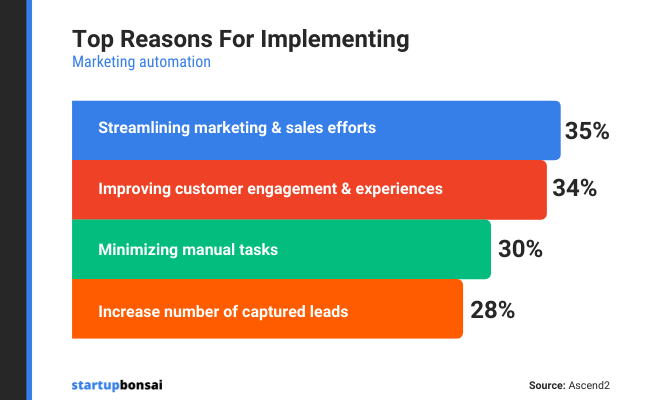
These benefits can improve your bottom line: 80% of marketers that use it report an increase in leads, and the average ROI of software comes in at $5.44 for every dollar spent.
Think about which tasks you want to automate in your processes. Make a list of needs and wants. This will make it easier to evaluate different platforms. For example, if you want to automate email onboarding to engage new customers, you can look at email marketing automation software.
Software can automate some or all common marketing tasks:
When comparing different platforms, look at how they perform in these areas:
- Cost: Do pricing plans match your budget? Are there any hidden costs or extra charges for supplementary features? Promotional offers can be enticing, but it’s important to understand how much a product will cost after an introductory period ends.
- Scalability: Can the platform grow with your business? Many platforms offer different plans based on the number of users. This can be useful to scale features according to your needs.
- Features: Does the software do everything you need it to? Essential features include analytics, CRM integration, A/B testing, and workflow creation.
- Customer support: If something goes wrong, can you easily get help? Software should offer a community help center and ticket support at a minimum. Bonus points if it offers email, phone, social media, or live chat support.
- Training: Regardless of how user-friendly software is, there’s likely to be some learning curve involved. Are help guides and videos available? Is expert assistance available? To get the most from the software, every member of your marketing team should be confident using it.
Take advantage of free plans or trial periods. This will give you a chance to test a product to see how it works for your business before committing financially.
Learn more about marketing automation and how it works.
Gather and Analyze Data to Improve Marketing Effectiveness
To judge how effective your marketing is, analyze results, customer sentiment, and conversions. Don’t rely on guesswork or gut feelings.
94% of businesses say data and analytics are important to their business growth and digital transformation, with benefits ranging from improved efficiency and productivity to better decision-making and more effective acquisition and retention.
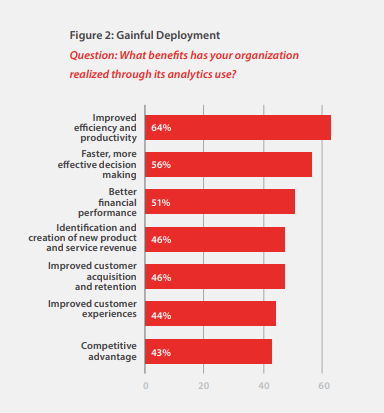
Your marketing goals will inform which specific key performance indicators (KPIs) to track and where to track them, but here are the essentials as detailed in our guide to KPIs you need to be monitoring:
- Sales growth: How marketing campaigns influence total revenue
- Leads: The number of leads generated. More leads mean a better chance of growth
- Customer lifetime value: How much you can expect from one customer over a lifespan. The more a customer is worth, the more important it is to retain them
- Digital marketing ROI: How much marketing brings in versus how much you spend. This will indicate whether you should continue your efforts or pull a campaign
- Customer acquisition cost:How much each customer costs to convert. This is calculated by dividing your total marketing investment divided by the number of customers acquired.
- Website traffic to lead ratio: The number of visitors that have converted to leads
- Website traffic to Marketing Qualified Lead (MQL) ratio: The total number of leads that are promoted to MQL. A low number indicates an issue with targeting or messaging.
- Website traffic: The number of people who have visited your website, who they are, and where they came from
- Social media marketing reach and engagement: The number of likes, shares, and comments your organic and paid social content has earned
- Email marketing performance: The number of people who have received, opened, clicked through or shared your emails. This will help you identify which elements of emails resonate with customers.
- Inbound link building: Information on who’s linking to your website. A high number of reputable and relevant domains can improve search rankings.
- Landing page conversions: The number of landing page visitors who took action. Use this data to test different aspects of your landing pages (e.g., CTA copy, button placement, or imagery).
- Blog post visits: The posts with the most engagement. Popular posts can be repurposed and keywords used to create additional content.
- Organic traffic: The website pages that attract the most visitors
- Net Promoter Score (NPS): How satisfied your customers are, and how likely they are to recommend you to friends and family
- Follower growth: The number of followers you’ve added since your campaign launched
- Search rankings: Your position in search results for your target keywords. Popular keywords provide direction for future campaigns.
Learn more about how to measure SEO performance in our complete guide.
List all marketing tools and analytics platforms in your strategy document, including login details and the key metrics to monitor in relation to your SMART goals.
Final Thoughts
Your marketing strategy is the foundation that drives your marketing initiatives. Getting it down might take weeks or months, but by doing the research and strategy work, you’ll put yourself ahead of many marketers and set your business up for years of success.
Revisit your strategy every six months or after each major strategic marketing campaign to review data and results and pivot or optimize as needed. Goals, segments, competitors, and marketing techniques evolve. Planning and executing future campaigns is easier with accurate data.
